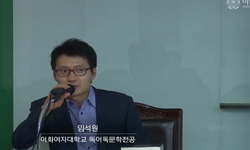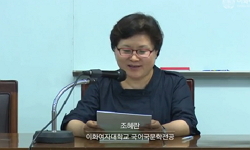Yeshik Tong’go(例式通攷) is an Expenditure record compiled in 1826 (26th year of King Sunjo’s reign), and was a document similar to another sister record named Takji Jeong’rye, compiled during the reign of King Yeongjo. Yeshik Tong’go was ...
http://chineseinput.net/에서 pinyin(병음)방식으로 중국어를 변환할 수 있습니다.
변환된 중국어를 복사하여 사용하시면 됩니다.
- 中文 을 입력하시려면 zhongwen을 입력하시고 space를누르시면됩니다.
- 北京 을 입력하시려면 beijing을 입력하시고 space를 누르시면 됩니다.
https://www.riss.kr/link?id=A105243798
- 저자
- 발행기관
- 학술지명
- 권호사항
-
발행연도
2018
-
작성언어
Korean
- 주제어
-
KDC
900
-
등재정보
KCI등재
-
자료형태
학술저널
- 발행기관 URL
-
수록면
269-306(38쪽)
-
KCI 피인용횟수
2
- DOI식별코드
- 제공처
- 소장기관
-
0
상세조회 -
0
다운로드
부가정보
다국어 초록 (Multilingual Abstract)
If we compare types of items and figures (indicating their spent amount) recorded in Yeshik Tong’go with those in Takji Jeong’rye, we can see the former only documented far lesser items, reflecting the real expenditure at the time (around Yeshik Tong’go’s compilation). Unlike Takji Jeong’rye, Yeshik Tong’go only revealed the names of royal family members who received materials from tributes around 1826, as well as the number of personnel who served them[宮屬].
Throughout King Sunjo’s reign, the basic foundation for central revenue -the “Chulse Shil-gyeol(出稅實結)” lands- continued to diminish, and the revenue of major financial offices (such as the Hojo Ministry and the Seon’hye-cheong office) continued to drop accordingly. On the other hand, central expenditure was something the government could not reduce at will, as for example, the Hojo Ministry had to spend money for essential purposes while creating new principles[定式] to accommodate certain needs. As a result, items spent for the royal family and (by) individual offices became less and fewer than what was spent and recorded at the time of Takji Jeong’rye. Items delivered to the royal family usually occupied the largest percentage of the government’s general spending, yet the number of types (of items) recorded as spent in Yeshik Tong’go is only half of what is recorded in Takji Jeong’rye. Other records, such as chronological documentation of the government’s court deliberations (for example, Shillok), also seem to be concurring with the figures recorded in Yeshik Tong’go.
In other words, Yeshik Tong’go vividly shows us the government’s efforts (up until the early half of the 19<SUP>th</SUP> century) to cut spending for the royal family. Previous studies attributed the financial deficit of the government in the 19<SUP>th</SUP> century to the supposedly increasing expenditure of the royal family, but examinations in this article prompt us to search for other reasons that would have contributed to such deficit, as well as elements that could have affected the government’s both revenue and expenditure in this particular century.
Yeshik Tong’go(例式通攷) is an Expenditure record compiled in 1826 (26th year of King Sunjo’s reign), and was a document similar to another sister record named Takji Jeong’rye, compiled during the reign of King Yeongjo. Yeshik Tong’go was different, however, from Takji Jeong’rye as the former was created for internal use only, to help the Jeon’rye-bang office -of the Hojo Ministry (in charge of central expenditure)- manage resources (which were to be delivered to the royal family) or materials collected from individual offices. To serve such purpose, Yeshik Tong’go assumed a slightly different form from Takji Jeong’rye.
If we compare types of items and figures (indicating their spent amount) recorded in Yeshik Tong’go with those in Takji Jeong’rye, we can see the former only documented far lesser items, reflecting the real expenditure at the time (around Yeshik Tong’go’s compilation). Unlike Takji Jeong’rye, Yeshik Tong’go only revealed the names of royal family members who received materials from tributes around 1826, as well as the number of personnel who served them[宮屬].
Throughout King Sunjo’s reign, the basic foundation for central revenue -the “Chulse Shil-gyeol(出稅實結)” lands- continued to diminish, and the revenue of major financial offices (such as the Hojo Ministry and the Seon’hye-cheong office) continued to drop accordingly. On the other hand, central expenditure was something the government could not reduce at will, as for example, the Hojo Ministry had to spend money for essential purposes while creating new principles[定式] to accommodate certain needs. As a result, items spent for the royal family and (by) individual offices became less and fewer than what was spent and recorded at the time of Takji Jeong’rye. Items delivered to the royal family usually occupied the largest percentage of the government’s general spending, yet the number of types (of items) recorded as spent in Yeshik Tong’go is only half of what is recorded in Takji Jeong’rye. Other records, such as chronological documentation of the government’s court deliberations (for example, Shillok), also seem to be concurring with the figures recorded in Yeshik Tong’go.
In other words, Yeshik Tong’go vividly shows us the government’s efforts (up until the early half of the 19<SUP>th</SUP> century) to cut spending for the royal family. Previous studies attributed the financial deficit of the government in the 19<SUP>th</SUP> century to the supposedly increasing expenditure of the royal family, but examinations in this article prompt us to search for other reasons that would have contributed to such deficit, as well as elements that could have affected the government’s both revenue and expenditure in this particular century.
목차 (Table of Contents)
- 머리말
- 1. 『예식통고(例式通攷)』의 자료적 성격
- 2. 『예식통고』의 항목구성
- 3. 『예식통고』의 편찬배경과 의의
- 맺음말
- 머리말
- 1. 『예식통고(例式通攷)』의 자료적 성격
- 2. 『예식통고』의 항목구성
- 3. 『예식통고』의 편찬배경과 의의
- 맺음말
- 참고문헌
- Abstract
참고문헌 (Reference)
1 최주희, "특집2논문: 18세기 중반『탁지정례(度支定例)』류(類) 간행의 재정적 특성과 정치적 의도" 한국역사연구회 (81) : 251-288, 2011
2 손병규, "통계로 보는 조선후기 국가경제" 성균관대학교출판부 2013
3 최주희, "조선후기 재정운영과 시장정책을 둘러싼 중앙정부의 딜레마" 한국역사연구회 (94) : 147-156, 2014
4 최주희, "조선후기 宣惠廳의 운영과 中央財政構造의 변화 : 재정기구의 합설과 지출정비 과정을 중심으로" 고려대학교 대학원 2014
5 홍순민, "조선시대 궁녀의 위상" 역사문제연구소 (68) : 241-267, 2004
6 조영준, "조선 후기 왕실재정과 서울상업" 소명출판 2016
7 오수창, "오늘날의 역사학, 정조 연간 탕평정치 및 19세기 세도정치의 삼각대화" 역사문제연구소 (116) : 204-234, 2016
8 최주희, "영조대 중반 균역법 시행논의와 <宣惠廳定例>의 간행" 한국사연구회 (164) : 193-236, 2014
9 임혜련, "영조~순조대 惠慶宮의 위상 변화" 조선시대사학회 (74) : 75-107, 2015
10 이경구, "새롭게 보는 정조와 19세기" 역사문제연구소 (115) : 106-126, 2016
1 최주희, "특집2논문: 18세기 중반『탁지정례(度支定例)』류(類) 간행의 재정적 특성과 정치적 의도" 한국역사연구회 (81) : 251-288, 2011
2 손병규, "통계로 보는 조선후기 국가경제" 성균관대학교출판부 2013
3 최주희, "조선후기 재정운영과 시장정책을 둘러싼 중앙정부의 딜레마" 한국역사연구회 (94) : 147-156, 2014
4 최주희, "조선후기 宣惠廳의 운영과 中央財政構造의 변화 : 재정기구의 합설과 지출정비 과정을 중심으로" 고려대학교 대학원 2014
5 홍순민, "조선시대 궁녀의 위상" 역사문제연구소 (68) : 241-267, 2004
6 조영준, "조선 후기 왕실재정과 서울상업" 소명출판 2016
7 오수창, "오늘날의 역사학, 정조 연간 탕평정치 및 19세기 세도정치의 삼각대화" 역사문제연구소 (116) : 204-234, 2016
8 최주희, "영조대 중반 균역법 시행논의와 <宣惠廳定例>의 간행" 한국사연구회 (164) : 193-236, 2014
9 임혜련, "영조~순조대 惠慶宮의 위상 변화" 조선시대사학회 (74) : 75-107, 2015
10 이경구, "새롭게 보는 정조와 19세기" 역사문제연구소 (115) : 106-126, 2016
11 송양섭, "正祖의 왕실재정 개혁과 ‘宮府一體’論" 대동문화연구원 (76) : 79-128, 2011
12 박 범, "正祖代 壯勇營의 軍制와 財政運營" 고려대 2018
13 金明淑, "勢道政治期(1800-1863)의 政治行態와 政治運營論 : 反安東金氏勢力을 중심으로" 漢陽大學校 大學院 1997
14 노대환, "19세기 정조의 잔영과 그에 대한 기억" 역사문제연구소 (116) : 176-203, 2016
15 김용흠, "19세기 전반 勢道政治의 형성과 政治運營" 한국사연구회 (132) : 179-220, 2006
16 임혜련, "19세기 수렴청정 연구" 숙명여자대학교 대학원 2008
17 임혜련, "19세기 國婚과 安東 金門 家勢" 고려사학회 (57) : 227-259, 2014
18 박미선, "18・19세기 왕실유모의 범위와 위상 — <度支定例>와 <例式通考>를 중심으로 —" 역사연구소 (73) : 37-75, 2011
19 최주희, "18세기 중반 定例類에 나타난 王室供上의 범위와 성격" 한국학중앙연구원 (27) : 38-69, 2012
동일학술지(권/호) 다른 논문
-
- 한국역사연구회
- 김인걸(Kim In-geol)
- 2018
- KCI등재
-
- 한국역사연구회
- 정동훈(Jung Dong-hun)
- 2018
- KCI등재
-
- 한국역사연구회
- 정동훈(Jung Dong-hun)
- 2018
- KCI등재
-
- 한국역사연구회
- 오기승(Oh Ki-seung)
- 2018
- KCI등재
분석정보
인용정보 인용지수 설명보기
학술지 이력
| 연월일 | 이력구분 | 이력상세 | 등재구분 |
|---|---|---|---|
| 2026 | 평가예정 | 재인증평가 신청대상 (재인증) | |
| 2020-01-01 | 평가 | 등재학술지 유지 (재인증) |  |
| 2017-01-01 | 평가 | 등재학술지 유지 (계속평가) |  |
| 2013-01-01 | 평가 | 등재학술지 유지 (등재유지) |  |
| 2010-01-01 | 평가 | 등재학술지 유지 (등재유지) |  |
| 2008-01-01 | 평가 | 등재학술지 유지 (등재유지) |  |
| 2006-01-01 | 평가 | 등재학술지 유지 (등재유지) |  |
| 2005-10-05 | 학술지명변경 | 한글명 : 역사와 현실 -> 역사와 현실외국어명 : 미등록 -> YŎKSA WA HYŎNSIL |  |
| 2004-01-01 | 평가 | 등재학술지 유지 (등재유지) |  |
| 2001-01-01 | 평가 | 등재학술지 선정 (등재후보2차) |  |
| 1998-07-01 | 평가 | 등재후보학술지 선정 (신규평가) |  |
학술지 인용정보
| 기준연도 | WOS-KCI 통합IF(2년) | KCIF(2년) | KCIF(3년) |
|---|---|---|---|
| 2016 | 0.91 | 0.91 | 0.87 |
| KCIF(4년) | KCIF(5년) | 중심성지수(3년) | 즉시성지수 |
| 0.87 | 0.92 | 1.68 | 0.36 |




 DBpia
DBpia





